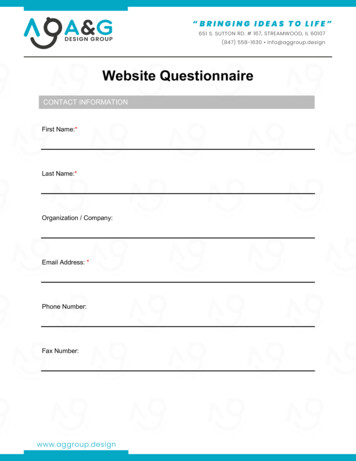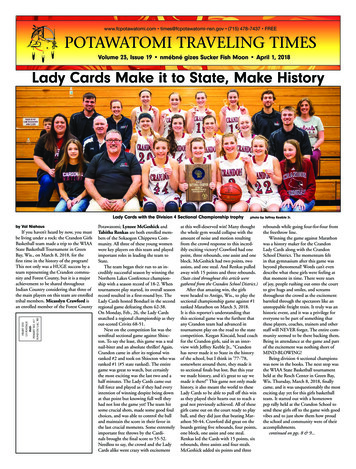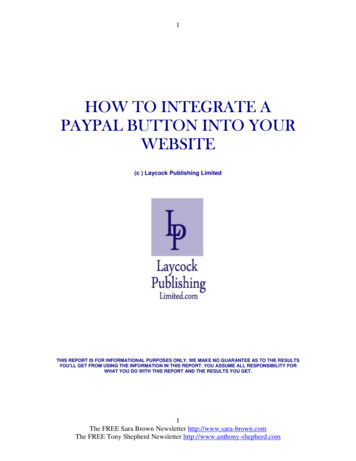
Transcription
DOES YOUR WEBSITEMAKE THE GRADE?Chances are, it’s barely passingby MIMI ANwith contributions fromJEFFREY VOCELL and KIERAN FLANAGAN
HubSpot Does Your Website Make The Grade?Table of ContentsClick Chapter Titles to Go Directly to the Page01 /Introduction . . . . . . . . . . . . . . . . . . . . . . . . . . . . . . . . . . . . . . . . . . . . . . . . . . . . . . . . .3Are Websites Making The Grade?02 /Performance . . . . . . . . . . . . . . . . . . . . . . . . . . . . . . . . . . . . . . . . . . . . . . . . . . . . . . .503 /Mobile Readiness . . . . . . . . . . . . . . . . . . . . . . . . . . . . . . . . . . . . . . . . . . . . . . . . . . . . . . .904 /SEO (Search Engine Optimization) . . . . . . . . . . . . . . . . . . . . . . . . . . . . . . . . . . . . .1105 /Security . . . . . . . . . . . . . . . . . . . . . . . . . . . . . . . . . . . . . . . . . . . . . . .1406 /What This Means . . . . . . . . . . . . . . . . . . . . . . . . . . . . . . . . . . . . . . . . . . . . . . . . . . .162
HubSpot Does Your Website Make The Grade?01 /INTRODUCTIONThe New Metrics of Website SuccessThe grades are out forWhat makes a website great? And more importantly to businesses, what26,093 websitesmakes a website rank? It used to be that great content and design alonewere enough. Today, new factors determine a website’s success. Now, great,high ranking websites have:1234Strong performanceMobile optimizationSearch engine optimization (SEO)SSL security enabledHubSpot’s Website Grader tool allows businesses to get a breakdown ofwhere their site is strong and where it needs improvement across thosefour areas. HubSpot Research has analyzed the results of over 26,000submissions to benchmark how websites are doing today.3
HubSpot Does Your Website Make The Grade?ARE WEBSITES MAKING THE GRADE?Not really. The average grade for websites is 60 out of 100. That’s a D-.Where are websites falling down? Across the board, HubSpot Research sees gaps in all fourattributes.KEY WEBSITE STATSOn average, the websites analyzed by HubSpot:s Take 3.9 seconds to load.s Have a page size of 1.4 MB. Sites in the bottom 25th percentile average3.4 MB in size, which is almost 1.5 MB larger than our recommended 2 MB.s Have 61 page requests.4
HubSpot Does Your Website Make The Grade?02 /PERFORMANCEOverall, websites are scoring just 18.5 points out of 30 in performance. For HubSpot,performance means how quickly a website loads content for each visitor. Many websiteshave factors which slow them down. We’ll cover each element of the score in detail.85% of websites have render blocking - a solid number but it can be improved.Not sure what render blocking is? Picture driving on a one lane road. If there’s construction,or something that’s blocking traffic in your lane, the obstruction has to be cleared beforeyou can move on. This is similar to how a browser loads a webpage. If the browserencounters an external script (such as a Twitter module or a third party service the websiteis using), that script must first make a request, load, and finish before the browser cancontinue to load other assets on the page.To speed up performance within the context of render blocking, HubSpot has tworecommendations:1. Defer any non-critical 3rd party scripts to load after all your core website content.This may extend your Time to Load (TTL) metric, but it will make for a fasterrendering experience.2. Remove or make scripts asynchronous so they load in conjunction with the restof your page.5
HubSpot Does Your Website Make The Grade?Just 68% of websites have compression.This can cover two elements: 1. Size of images, which typically are the #1 source of slowloading pages and 2. the variable weight of the remaining javascript and css resources on thepage (WebSite Grader requires that at least 50% of a website’s JS/CSS resources have beencompressed).Compression can especially help browsers load image heavy pages faster. When a browseris downloading the contents of a website and encounters an uncompressed image, it mustdownload the entire image and then resize the image based on how the website developerhad configured it on the page. This means that an image may be set to display on the pageas 500 x 500 pixels, but the source file that must be downloaded first could actually be 5000x 5000 pixels. The browser must load that massive image first. Without compression, thatoriginal source image is potentially 4MB in size. Imagine a user connecting to the websiteusing the cellular connection on their mobile phone -- and being forced to download a 4 MBimage just to load the home page.When an image is compressed, that same 4MB image could become 2.4MB and save thebrowser from loading that additional 1.6MB. Further, if your website is image heavy, considerimage resizing to speed up performance. Using the same example above, if the browser onlyneeds to load the 500x500 image, it would save even more space and load more quickly.To clean up Javascript or CSS code on your webpage, compression, also commonly knownas minification, removes redundant comments and code or shortens the code and functions.There are many tools available that allows website developers to minify their JavaScript orCSS code.Only 45% of websites have browser caching.Browser caching is a way of storing some commonly used website files locally, so the browserdoes not have to re-download them every time it accesses that website. JavaScript, CSS, andimage files can be cached and thus save the browser from loading those resources when thevisitor comes back to that site. Websites that experience a lot of return visitors should havebrowser caching as a best practice.2% of websites have redirects.Since so few sites have redirects, this performance component isn’t a problem today.Redirects can cause load time problems when a browser begins to download content from“page 1” then encounters the redirect and has to load content from “page 2”.6
HubSpot Does Your Website Make The Grade?BREAKDOWN OF PAGE LOAD SPEEDSSpeed to load is the key performance component for websites today. The websites in ourdataset take 3.9 seconds to load on average. All websites should aim to load in 3 seconds orless. Speed is important because studies indicate that 40% web users expect a load time of3 seconds or less. Otherwise they’ll abandon a site completely. Consumers who stick aroundend up developing a negative brand perception for businesses with slow websites: “79% ofshoppers who are dissatisfied with website performance are less likely to buy from the samesite again”. Slow sites affect a business’ bottom line. It’s definitely possible to increase speeds-- for websites in the top quartile of our dataset, the load time is 1.11 seconds or less.The figure below breaks down the ‘heaviness’ of a site and their corresponding load times. Onthe whole, the data is intuitive: larger sites take more time to load. However, administratorsof websites that are 15-20 MB in size have found ways to optimize their site to buck the trendand load faster. Besides following the best practices listed about, websites of that size likelyhave invested in a CDN, or has done some FEO (Front-End Optimization) to speed up loadtimes. However, once websites get beyond 20MB, the average load time becomes untenable.For those old enough to remember, 27 second load times recall the old dial up days when7
HubSpot Does Your Website Make The Grade?WHAT TO DO TO FIX YOUR PERFORMANCE SCOREEnterprises with complex, heavy websites can do the following to ensure thatload time isn’t compromised:1Compress and resize images as much as possible.2Reduce, or remove, any non-asynchronous requests. Everything should loadas quickly as possible, and anything that is blocking this from happeningshould be removed or deferred.3CSS spiriting can be extremely effective method for loading images, if youhave a developer or someone familiar with the technique.4Minify all your code, especially JavaScript.5If you have long pages, defer loading some of the content until the userbegins scrolling.6Think strategically about the order assets are loading in. Your main CTAshould not be last on your page because the user will have likely movedbeyond that CTA by the time it displays.8
HubSpot Does Your Website Make The Grade?03 /MOBILE READINESSThe mobile readiness score is slightly better, with websites getting an average of 21 outof 30. Mobile readiness relates to how well a website loads and performs on a range ofmobile devices.The two key attributes HubSpot focus on is whether the site is mobile responsive andif it has view ports that allow website administrators control the width and scale of theirpages as they appear on different devices. 72% of the websites we analyzed have viewports and 68% are mobile responsive. These numbers are higher than enterprise norms: arecent study in April 2015 found that only 44% of Fortune 500 websites are mobile ready,which makes sense given that enterprises tend to have websites that span hundreds if notthousands of pages, host websites on internal legacy systems, and have a slow pace oftechnical change. When it comes to mobile readiness, SMBs are able to punch above theirweight and favorably rank against the big guys.This is because Google looks for mobile responsiveness or a dedicated mobile site in theirsearch algorithms. All businesses should focus on ensuring their websites are mobile ready.9
HubSpot Does Your Website Make The Grade?On the whole, Google recommends the responsive design methodology above setting up aseparate mobile site, perhaps selfishly, since it’s easier for their web crawlers review a singleresponsive site rather than two separate sites (mobile and desktop). Responsive design isbetter for the a website’s SEO too, as the risk of cannibalization via a separate mobile siteis eliminated. Google (and other search engines as well) also treat mobile ranking slightlydifferently than desktop. A company could have the #3 position for a keyword on a desktop,but if they’re website is not optimized for mobile, they may not even be on the first page.HubSpot’s resident SEO and mobile expert Kieran Flanagan sums it up: “Being mobile readyis extremely important today. According to Neustar, 80% of mobile phone searches lead to apurchase or another action within a few hours. If your website is not optimized and showingup in mobile search results, you could be losing potential customers.”WHAT TO DO TO FIX YOUR MOBILE SCORETo get mobile ready:1Run your website through Google’s mobile friendly test to find out where yourwebsite stands.2Strategize the right optimization option for you: responsive design or aseparate mobile site. HubSpot recommend responsive design since it’sfavored by search engines, but either will work.3Plan your next website redesign around mobile behavior.“Being mobile ready is extremely important today. .Ifyour website is not optimized and showing up in mobilesearch results, you could be losing potential customers.”10
HubSpot Does Your Website Make The Grade?04 /SEOSearch engine optimization (SEO) is a comparatively mature practice in internetmarketing, yet the average score for SEO is 18.6 out of 30. It is surprising to seesuch low scores but luckily this attribute is the easiest for marketers and websiteadministrators to address directly. The scores also reinforces that notion that aconsistent and thorough approach to SEO is key.As new web pages are added, SEO may become spotty across a website. Websites todayoften have various authors across different pages. Not all website contributors are trainedin SEO basics to ensure pages follow a strategy of interlinking or are designed to preventcannibalization from a pre-existing page. As website content explodes, a meta descriptionor heading tag may be overlooked, and many pages that are added are not optimized.Over time, these gaps across individual pages build on each other to negatively affect asite’s overall SEO. Marketers should focus on auditing their pages, finding the gaps, andfixing them. A regular audit should be scheduled to ensure SEO optimization doesn’t fallthrough the cracks as websites grow.11
HubSpot Does Your Website Make The Grade?77% of websites have page titles.This number should be 100%. No excuses! Page titles are a basic element of page design andappear in search results. The 70 characters that comprise a page title directly impact searchranking and click through rates (CTRs).61% have heading tags.Headings, or H1 tags, reinforce the keywords found in the page title, and orients the visitor tothe contents of the web page. A visitor will want to see heading tags that relate to the topicthey were looking for.57% have site maps.There is some debate on how important sitemaps really are to SEO. According to Google,“in most cases, your site will benefit from having a sitemap, and you’ll never be penalizedfor having one.” Especially for larger website (those with more than 60 pages, which is themajority of our sample), including a sitemap is a best practice that allows your web visitors toeasily navigate your site.Just 42% have properly configured meta descriptions.A meta description is the few lines of text (155 characters or less) that appears under yourpage title in a search result. It effectively describes the content of the webpage to a potentialwebsite visitor. It should clearly outline what’s in the page and why someone should click intothe link. Without it, a searcher has no real insight on what’s in your page. Likewise, if you havemore than 155 characters, the description gets cut off. Meta descriptions are just as vital toclick through rates (CTRs) as the page titles, and should not be overlooked.12
HubSpot Does Your Website Make The Grade?WHAT TO DO TO FIX YOUR SEO SCORE1Perform an audit of your website. Seek out and address missing page titles,heading tags, and meta descriptions.2If your website has many pages but lacks a site map, consider creating one. Itwill give visitors to your site an easier way to navigate and can only positivelyimpact your website’s SEO.3Review the pages in your website to ensure that pages aren’t cannibalizingSEO ‘points’ from each other. For example, an electronics business may havemultiple pages optimized for ‘best kitchen appliance.’ Those pages competewith each other for search traffic. Consider consolidating duplicate pages orcreating a crosslinking strategy.13
HubSpot Does Your Website Make The Grade?05 /SECURITYBusinesses are failing their customers when it comes to security. Only 1 in 5 sites we’veanalyzed is protected by SSL.SSL (Secure Sockets Layer) creates a secure tunnel between a visitor’s browser and awebsite’s web server. The information that is sent over the tunnel is protected, so thata third party can’t peer into the data. It protects the exchange data between the twoendpoints, such as a visitor’s username, login password, email address or the personalizedcookies that the website sends to the visitor.Since Google’s recent announcement that SSL will be a ranking factor in search results,all business must start prioritizing the security of their sites. In fact, one of Google’sWebmaster Trends Analysts said that HTTPS can be a ranking tie-breaker between twootherwise equal sites. So SSL doesn’t just keep your visitor’s connection to your websitesecure, it also has a strong SEO implications.14
HubSpot Does Your Website Make The Grade?More importantly, businesses need to safeguard their customers’ information. In the pastyears, historic breaches affecting Fortune 500 companies, as well as national governments,have been in the news. For every Target or Sony Pictures of the world, there are alsothousands of small businesses that, after being breached or affected, often suffer evenmore disastrous financial consequences. Most don’t have the funds to cope with the aftereffects of a breach and end up closing shop.WHAT TO DO TO FIX YOUR SECURITY SCORE1Ensure that your content management system has SSL capabilities enabled. Ifthey don’t, your options are unfortunately limited. Press your host’s customersupport and development teams to prioritize SSL and request a timeline. Afterseeing the increase in weight given to SSL sites and hearing feedback fromour customers, HubSpot recently enabled one-click SSL within its websiteplatform for free. If you cannot obtain a solid timeline for SSL protection fromyour website host, consider moving your site to a one that has SSL as a corefeature.15
HubSpot Does Your Website Make The Grade?06 /WHAT THIS MEANSThe majority of websites HubSpot analyzed would have received high marks five years ago,but websites today are clearly behind the curve. Website design, and its correspondinguser experience, operates on a sliding scale that evolves over time. Mobile responsiveness,security, and many aspects of SEO and performance we covered in this report weren’tas big of a factor in the past. But technology has changed so much, what didn’t matteryesterday makes all the difference today.What does this mean for marketers now? Websites should undergo iterative improvementsover time, rather than a carte blanche redesign every couple of years. The model of settingand forgetting your website simply isn’t practical given the pace of technical change andthe fierce competition websites encounter to rank highly in search. Ongoing improvementsto your website will keep your organization ahead of the curve and help your websitemake the grade.The dataset consists of URLs submitted to websitegrader.com. HubSpot Research believes the data is compelling because activesubmissions indicate that the websites in the dataset are truly up and running, are maintained, and have at least one personactively working to improve it. Given that the total internet is massive and there are millions of dead websites, this dataset is areflection of today’s active website landscape. Over time we will append data and update this report.Outlier data, greater than 2 standard deviations from the average load time, was excluded from the analysis.16
HubSpot’s Website Grader tool allows businesses to get a breakdown of where their site is strong and where it needs improvement across those four areas. HubSpot Research has analyzed the results of over 26,000 submissions to benchmark how websites are doi











